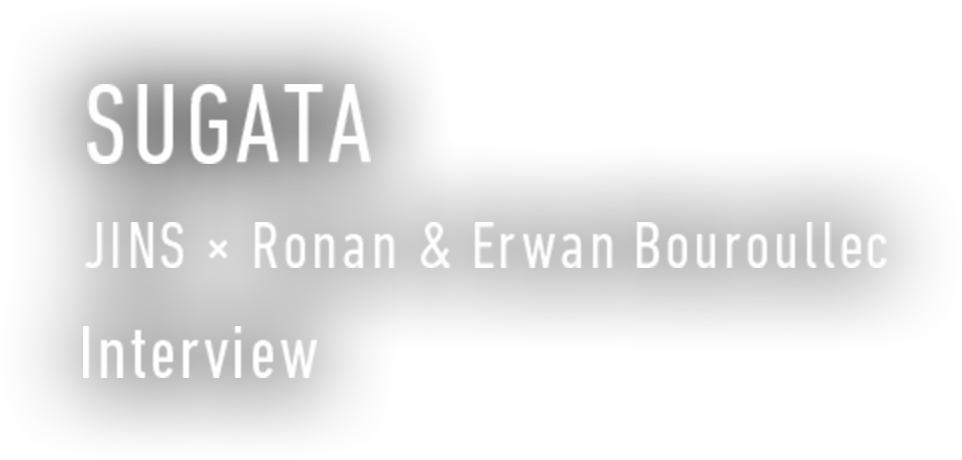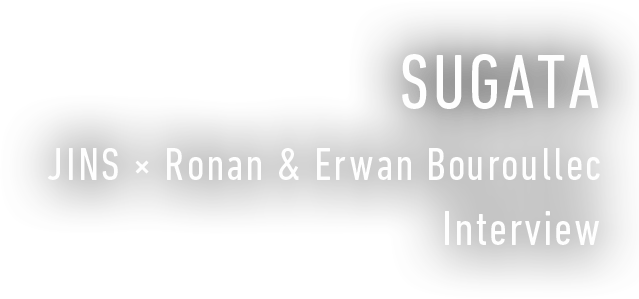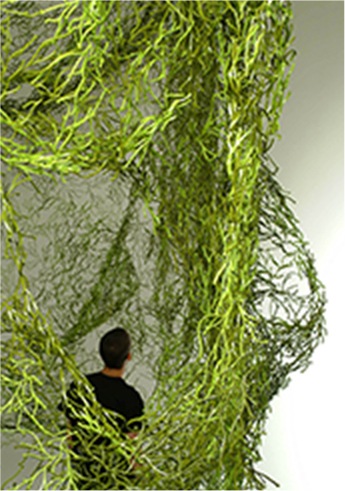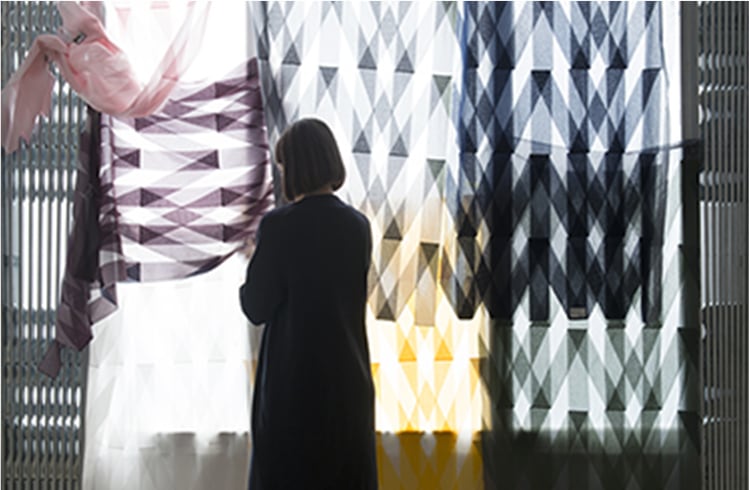



Slim and light with air-like transparency.
We attempted to achieve the minimal form of eyeglasses.


— RONAN
Eyeglasses are a product directly linked with the human body, and therefore different from interior design, the field in which we usually work. In the past, we had an opportunity to design jewelry. It was the first time we worked on designing something associated with the body, but fortunately the project was a success. However, eyeglasses are different from jewelry, too.
— ERWAN
It was four years ago when JINS approached us with their Design Project. When we are offered a new project, we always take time before responding but, this time, we took extra time to carefully consider the proposal. The more we thought about the project, the more we became attracted to it and, in the end, we came to the conclusion that the issues involving furniture and eyeglasses are the same. Both are profoundly connected to human motion and psychology, and have the potential to alter human behavior.
— RONAN
What we wished to focus on for this project was “elegance” and “gentleness”, and to come up with a tender design. What sort of eyeglasses should they be for the wearer? The important thing we always do in a design process is research. Material and technical aspects as well as colors are equally important but this time we began our research with the theme “What is elegance?”
— ERWAN
The next step was to start with conceptual drawings, not with actual drawings of eyeglasses. When we create a design, we always discuss it together. Of course, since Ronan and I have different ideas, conflicts can arise. But in such a case, we go back a step and do the drawings once again. The premise of our design is to share the same idea.






— ERWAN
One day, I got an inspiration for an idea that was refined. I remember it quite clearly. It was a Friday in May or June. It was a quiet, peaceful day. What I would call a typical “Japanese” day. Nobody was in the studio. I was alone and was working on a general framework of the design in a relaxed atmosphere. It was at that moment when what we had been pondering over for about half a year took shape. What could be said to be the DNA of this product presented itself. The relationship between the eyes and eyeglasses, the axial line of the frame, the curves that shape the form, all such essential factors were incorporated into the design using the computer. The design obviously was not completed on that day. In fact, we spent about another year creating test samples over and over again.
— RONAN
After taking these steps, we finally reached the idea of a minimal form of eyeglasses. What inspired us in the course of our endeavors were the eyeglasses that JINS had created so far. Their eyeglasses are incredibly light, unpretentious and blend naturally with the face.
— ERWAN
Yes! Reading glasses that I believe were pink. We were told by the JINS staff that the quality of plastic nowadays is flexible, soft and
yet strong, which we found very appealing. They were ergonomically sound and made with slim, resilient materials. Another thing that came up while examining many of JINS’ frames was a proposal regarding the part known as “yoroi,” which joins the rim of the lens and the hinge needed for opening and closing the frame.
We created a design that had a smooth line from the front to the hinge.
We deliberately decided to remove a part that is common to the image of eyeglasses.




— ERWAN
We gave much thought to the yoroi (the piece between the rim and hinge) part of eyeglasses. The yoroi has been an essential part of the conventional way of making eyeglasses when it comes to cutting and shaping the frames,and is probably the molding that embodies the history and memory of eyeglasses. But we dared to ask, “What if we deliberately eliminate this part?” Since JINS possesses superb plastic injection molding technology, and if it is functionally not a problem, we thought we might be able to do away with this part. As with human expressions and behavior, eyeglasses, which are worn on the face, are a very delicate matter. In the current project, we changed the traditional model of eyeglasses, but we always kept in mind that we should not end up making a bizarre product.
— RONAN
While we were eager to work on something new, at the same time, we needed to make something that would fit the faces of many people. We had to make sure the beauty of the wearer’s posture would not be compromised by transforming a pre-existing form. Our theme throughout was the overall balance of the frame. From round to square types, we examined extensively how to create light, elegant eyeglasses with a form that would naturally integrate with the contours of the human face.
— ERWAN
The removal of an inherited symbol is not that hard in itself. However, what is difficult is to ascertain what the wearer would look like when the part is eliminated, and what sort of a curve would fit and compliment the human form. We used our studio’s 3D printer to create trial models, while continuing to work with the JINS team in the form of frequent exchanges on technological aspects. Finally, we were able to develop strong, but light-as-air, comfortable eyeglasses.
Eyeglasses make up a person’s “posture”.
Particular attention was given to the curve of the front.
The top-bottom balance has been adjusted again and again.


— ERWAN
As for the form of the front, a detailed study was carried out to determine where to set the center of the frame, and whether it was better to put the center slightly off that of the wearer’s eyes. The balance between the front’s upper and lower parts and their sizes have also been adjusted over and over again. The minimal form as a whole is a result of all this research.
— RONAN
It wasn’t easy to realize the elegance factor. A tiny difference of 0.5 mm could alter the look from a serious feel to a mischievous one. As facial expressions of a wearer change, too, we have to carefully take into account the fact that fine details can change an impression. What would they look like? What sort of an impression would they make? At times, the process made me feel as if I were a film director.
— ERWAN
Although we have come up with 4 types – round, ellipse, square and classic – the underlying concept of the designs is all the same. There are a variety of different factors to consider, including the shapes of people’s faces and hairstyles. So, in choosing a pair of eyeglasses, we made the designs simple for the most part, so that people are able to try on slightly different types as well.


— RONAN
The colors were also determined in the same manner, by matching the colors with the expressions of many different people. As well as these forms, another factor we also considered was transparency.
— ERWAN
In line with the characteristic of “light as air”, we thought that a frame fused with the body, as if the frame is not even there, would be beautiful. We considered colors from pale to dark colors, grey and dark blue, and the classic brown. The combinations were not matched in a simple manner, like “this color for that type”, but each form and each color were closely coordinated.
— RONAN
The process of designing is similar to that of cooking. Just as you would check the taste while cooking, we carry out a test at each step. By repeating the process of making models until the right balance is achieved, the design becomes refined. For the current project, we believed that “different types of frames would complement the natural expression of the wearer.” The reason why we placed significance on airlike transparency was because we wanted the eyeglasses to be an integral part of the person’s posture. The beauty of a person is delivered through appearance and posture. The “SUGATA” design is complete when a person wears the form and color of each pair of eyeglasses.
Ronan and Erwan work together on a range of designs from urban planning to furniture and tableware. In their studio in Paris, multiple projects are in progress; drawings, models, textile samples and many other material samples are scattered all over the place. They say, “In any project, we take time to think about what is missing and what is needed.”
“Design is for people and it is an integral part of a culture. There are a variety of approaches to design, but rather than dividing the subject into smaller sections, we believe that it is essential to design with the very behavior of human beings in mind,” says Erwan states. “I’d say that another important factor is ‘transparency’. As the world, including distribution, is getting so complicated, with regard to each material, too, we like to give a lot of thought to the underlying meaning from a cultural standpoint as well. We also discover things when we listen to people. We are able to expand our ideas from all kinds of sources.”
Ronan continues, “The reality is that our world is not just filled with beautiful things. What we do through design is to find an interesting object and to explore ways to make it even better.” “The landscape, architectural structures, posture of a person sitting on a chair, ambience of a café, we see a lot of things and ponder about their beauty. Take, for example lighting, which I am particularly interested in: although lighting is very important, it is a fact that there are very few good colors of light bulbs, with which we are familiar, or in the atmosphere of cafés and restaurants. That is exactly why we collect even the most trivial of information so that we can make better products.
Both further claim that “What is important is ‘harmony’ and the research into balancing the various factors, and to understand about harmony.”

-

Photo: Studio Bouroullec

-

Photo: Studio Bouroullec


Photo: Studio Bouroullec

-

Photo: Studio Bouroullec

-

Photo: Studio Bouroullec

-

Photo: Morgane Le Gall

-

Photo: Studio Bouroullec










